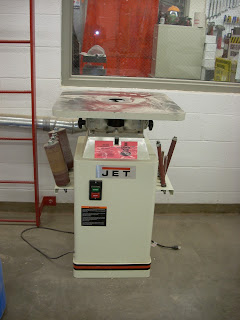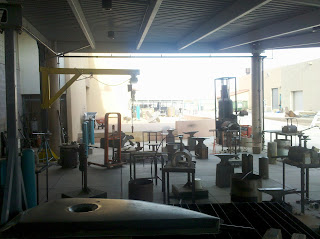Now that I had the frame more or less worked out, it was time to figure out how I was going to steer. Seeing as the front fork is an entire five feet from the forward-most riding position, this presented a bit of a challenge. I thought about just making some stupidly long handlebars, but that seemed pretty cumbersome and wouldn't allow for as tight of a turning radius as I wanted. This next option was to create some kind of remote steering mechanism and place the handlebars directly in front of the rider. The worry I had with that plan was that it would require there to be a bar running directly up between the rider's legs which could cause some serious problems in the event of a sudden stop.
The third option, and the one I chose to pursue was to place the handlebars under the seat.
Working off the example set by this home-made recumbent bike that sometimes shows up at the college I go to, I started with the idea of using a set of bars to connect the handlebars to the front fork remotely.
These are heim joints. As I understand it, they would have been a perfect solution for this task.
They have a ball shaped thingy with a hole in it inside some kind of collet thing, and you screw them onto whatever you're trying to make move and then put a screw through the hole in the ball thing or whatever, and they hold one thing in place and let another thing move around, I guess.
So, based on my obvious knowledge of how they work, and because buying things is for suckers, I decided to try something that would perform the same function, but that I would make myself. Not exactly knowing where to begin, what I decided I had to do first was to create mounting positions on the front fork for this not-yet-fully-concieved steering system.
I began by cutting two little pieces of 1/8th inch thickness steel and grinding them into a fat crescent moon kind of shape. I then drilled a hole in both of them of the same diameter as some round bar-stock that I found lying around.
Next, I ground the paint off of a couple places on the bike's front fork and welded the pieces I had just made on as straight and evenly as I could.
The next thing I decided to do was screw up. I was a little overly excited about making the bars that would go between the handlebars and the brackets I had just made, so I started on those. After getting about half-way through making them, I realized that I hadn't even thought to measure how long they had to be. In order to figure this out, I found a small step stool and placed it on the table over the frame so that I could sit on it and put my feet on the pedals to get an idea of how far the handlebars should be from them.
This revealed to me that the bars I had made were about six inches too short.
After doing that so successfully, I retrieved a pair of BMX handlebars from my pile of bikes. These conveniently had a bracket with screws in it that allowed me to set the handlebars at whatever angle I wanted. I set them to an angle of about 90 degrees.
I also retrieved the head tube that I had cut off the little pink bike previously. Using a plasma cutter, I cut a chunk out of each of the two lengths of tubing making up the front half of the bike to create a circular(ish) space.
I then cut the head tube in half horizontally, and used the bench grinder's wire brush wheel to clean the paint from the halves. Next, I slid one half into the top of the space and one half into the bottom of the space to meet in the middle, then tack-welded them in place.
This is a part I had made earlier on to put the handlebars temporarily onto the upper level of the bike.
If you remember, there had been a problem with the handlebars coming loose. This part was the culprit. I had made it from a piece of 16 gauge sheet and a left-over wedge nut. Because I did it hastily, the welds were too cold and therefore weak, so I wasn't able to tighten the bolt down adequately for fear of breaking them. Also, the circular piece I had made didn't fit well into the flange of the head-tube.
So I refined the size and shape of of the disk, and re-welded the two pieces together properly.
Once I was satisfied with that, I found all the parts of the headset assembly required to fix the handlebars to the bike,
and fixed the handlebars to the bike.
The next thing I had to do was create another mounting bracket to affix to the handlebars. To do this, I used a piece of 16 gauge steel, sheered it into a diamond shape and blunted the lethal looking points with the bench grinder.
Using the drill press, I then made two holes at the ends of the diamond and two toward the middle of the diamond at the same distance as the two screws on the handlebars closest to the pivot point.
Using the existing screws, I affixed the bracket to the bars.
I then turned my attention to the pieces of round bar I had found.
Now, I'm not totally sure, but it's possible that I may have stolen them. I did, however, leave my name and number and a very polite note, and thus far no police have shown up at my door, so I may be in the clear. Either way, don't tell anyone.
The bars had apparently been previously used for something, so they were pretty bent and twisted. Using a hammer, anvil and vice, I did the best I could to straighten them out.
Next I cut them to even lengths that matched the distance from the mounts I had put onto the front of the bike and the vacant holes of the bracket that was screwed onto the handlebars, plus an extra inch. Once I'd done that, I used a vice-grip to hold the two together parallel and clamped the other end down in the vice with 1/2 inch exposed.
Using a rosebud torch tip on an oxy-acetylene set, I heated the exposed 1/2 inch until it was glowing, then beat it to a 90 degree angle with a cross-peen hammer.
Then I did the same to the other side.
But because I wasn't paying attention, I did it the wrong way and had to straighten them out and do it again.
Amazingly, after all this, my measurements were right and everything fit correctly on the first try. Each of the 1/2 inch angled bits fit into their respective holes in each of the brackets. Each bar was exactly the right length. Once it was all put together, when the handlebars were turned, so too did the front fork. So, feeling very accomplished, I welded up all my seams, and took a victory nap.




























































